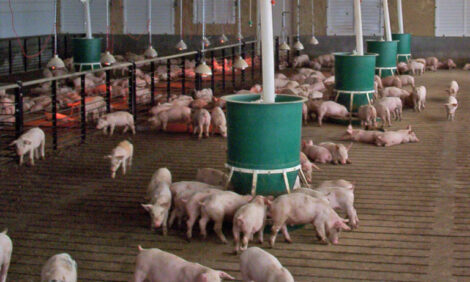



Group Housing Does Not Impair Sow Welfare
To improve welfare – and to comply with regulations in some countries – group housing systems for pregnant sows are gaining popularity. Despite concerns over the welfare of the animals is these dynamic groups, research at Giessen University in Germany indicates that there is no severe or long-term impairment of animal welfare.Verena Krauss and Steffen Hoy at the Justus Liebig University in Giessen, Germany, have investigated the social behaviour of sows in dynamic groups. Their paper was published recently in the journal, Applied Animal Behaviour Science.
In their investigation, 22 groups of sows (with a total number of 73 sows, partially observed repeatedly) were consecutively observed for 96 hours with the AgId of video technology after the introduction of five new sows into a group of 10 resident sows, thus creating a dynamic group of 15 animals.
The aim, explain the researchers, was to analyse the frequency of antagonistic interactions (AgI) and the lying behaviour of new and resident sows. Additionally, the lying behaviour three weeks after the introduction of new sows was recorded in half of the 22 groups.
The number of AgI per group was 45.2 on the first day and decreased significantly to 30.0 AgI/group on the fourth day after the introduction. Between 82.4 and 87.9 per cent of all AgI included the participation of at least one new sow.
Including all days of observation 2.3 AgI per dyad occurred between resident and new sows (n=50 dyads), 0.5 AgI/dyad within the subgroup of resident sows (n=45 dyads) and 1 AgI/dyad within the subgroup of new sows (n=10 dyads).
Altogether 12,454 lying events were recorded from which 6,134 occurred clearly either next to a member of the own subgroup (resident and resident, new and new) or next to a member of the other subgroup (resident and new or vice versa).
On the first day, new sows showed significantly more lying events than resident sows (21.2 and 14.9 in 24 hours, respectively).
By the 21st day this number decreased significantly (to 13.9 in 24 hours), which no longer showing significant difference from the number observed for resident sows (14.2).
On the first day, both resident and new sows lay down significantly more often next to a member of the own sub-group (new sows, 94.3 per cent; resident sows, 96.8 per cent). The number of lying events next to a member of the same sub-group decreased significantly within three weeks after the introduction of new sows, indicating the advancing integration of new sows into the dynamic group (new: first day, 94.3 per cent, 21st day 46.0 per cent; resident: first day 96.8 per cent, 21st day 74.6 per cent).
The researchers concluded that in general, providing environment and management are at least adequate, the process of introducing new sows into a dynamic group does lead to an increased level of aggression and agitation, but since this is only a short-term effect, no severe impairment on animal welfare is to be expected.
Reference
Krauss V. and S. Hoy. 2011. Dry sows in dynamic groups: An investigation of social behaviour when introducing new sows. Applied Animal Behaviour Science, 130:20-27.
Further Reading
| - | You can view the full report (fee payable) by clicking here. |
March 2011








